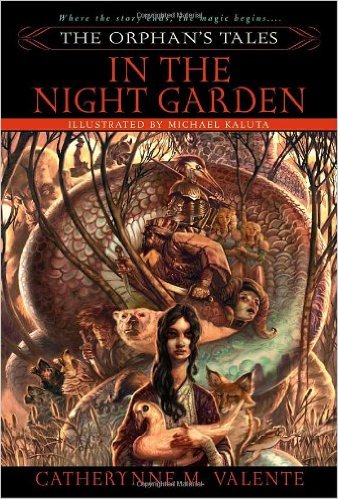 Tiffany Matthews wrote this review.
Tiffany Matthews wrote this review.
There is a strange gift for the reader at the heart of Catherynne M. Valente’s new novel, The Orphan’s Tales: In the Night Garden. Of the many prizes avid readers are granted while rustling through pages, there are common evocations; joy, sorrow, knowledge, comfort. While The Night Garden offers all these at one juncture or another, the enduring reward it left me with was one of dislocation. Reading this book is like drowning. There is the initial lurch and puzzlement, and then that same unhurried wonder and horror while journeying through the labyrinth of this text.
I will warn those curious about this book up-front: It will force you to let go of plot and timeline and characters and finally, the story itself. If you attempt to cling to these regular buoys that a reader relies upon, you will be lost. But, if you can sink into the narrative flow, let loose the nagging part of your mind that insists on sense, the dislocation engendered by the twisting shape of the story becomes a gift. And the gift is a key. And, as in all good tales, the key leads to a glistening treasure.
I suppose it’s fair to ask for a tad more concrete detail here. What’s the book about, for crying out loud? Who are the main characters? Where does it take place? These are perfectly appropriate questions to answer in a review, but the thing about this book is, it’s special. It defies pinning down like an insect in a collection case. That said, there are some basic facts I can share. This book is narrated by a profoundly peculiar girl who lives, feral, in the vast gardens gracing the estate of a King in undefined fairytale realm. Her tattooed eyes teem with weird and riveting stories, which she weaves for a young prince who stumbles into her bower one night. From here, everything becomes quickly murky. The story she tells is about stars who fall into bodies of flesh, about Amazon witches, wild beasts by turns ravening and gorgeous, forbidden fruit, golden geese, evil despots, brave wanderers, necromancers, doomed heroes, quests into dank caverns and over bloody seas.
Comparisons with The Arabian Nights are inevitable, but ultimately inadequate. As often, I was reminded of Le Guin or Gaiman or Hans Christian Andersen or Robert Anton Wilson or Lewis Carroll or Tolkien. There are shades of all these, as well as purposeful plunderings of centuries-old tales. Yet these are not re-tellings of fable. The turns these stories take are so unexpected that the reader is repeatedly jolted from the comfortably trodden traditional narrative path. In the fashion of the most dedicated and accomplished storytelling, one story spins out into another story, which branches into yet another vision, until the reader is breathless, and unfailingly confronted with the realization that the ground underfoot is utterly unstable. I can see how this would be very unsettling to contemporary fantasy readers, as we are inundated with multi-volume series wherein each step leads clearly, thrillingly, to the next. However, every experienced traveler knows that there is profound pleasure to be discovered in allowing oneself to drop off the edges of the plan and become lost.
Valente’s prose is creative and sophisticated; her imagery is intricate and arresting. Her skill is the treasure that allows this textual matryoshka to work. Each individual story is polished and utterly absorbing- a world unto itself, from which the reader is pulled away too soon. Yet the author immediately sweeps into the delights of another new character, new puzzle, new danger. One moment the reader is enraptured with a battle between a leucrotta and a shape-shifting bear, the next moment, empathizing with an outcast sorceress, and the next, mourning the fall of a race of wild horses. This extraction and re-immersion happens so completely, so frequently, that after a while the reader reaches a Zen-like state, bobbing along the narrative sea like driftwood, though not nearly so detached. Some tales had me laughing out loud, some tapped a deep well of happiness, and at least one left me with such a lingering sense of horror that I could not pick the book up again for days. I should note here that this is not a book of fairytales for children; it is often dark and sometimes unflinchingly violent. However, it is frequently marked by a transcendent beauty as well.
Any lover of well-written fantasy will find much to enjoy about Valente’s book, for the dozens of diverse and extraordinary tales in the volume share magic as their binding factor. And like an impossible mystery that one can never untangle before the denouement, patterns and protagonists from all through the book do mesh like puzzle pieces by the Tales’ end. Valente’s philosophy on the unusual structure of the novel seemingly peeks through when a sainted pirate remarks, “Stories . . . are like prayers. It does not matter when you begin, or when you end, only that you bend a knee and say the words.” Reverence is a key theme cutting across all the winding pathways of story in the book, reverence for language, for spirituality, for nature, for friendship, sacrifice, determination, and for the wonder in the world that can’t be explained away.
(Bantam, 2006)
